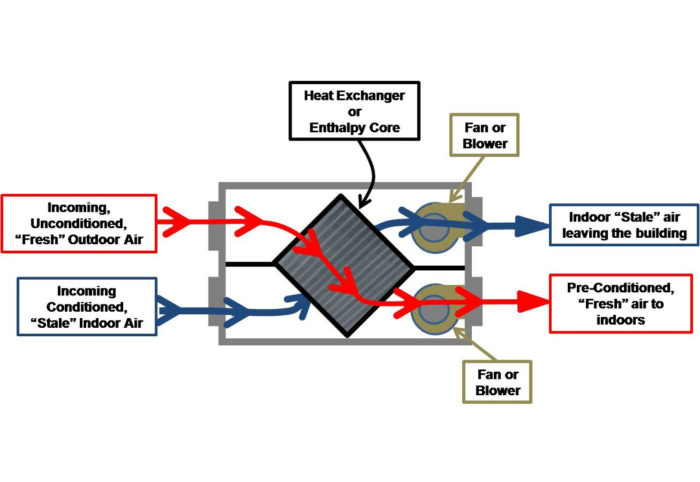What Is HRV and Why It Matters for Energy Savings
The All-Inclusive Overview to the Uses of Heat Recovery Ventilation in Modern Buildings
Heat Recovery Ventilation (HRV) systems represent a substantial innovation in constructing innovation (HRV Heat Recovery Ventilation). They give a method for trading stagnant indoor air with fresh outside air while decreasing energy loss. This technique not just enhances indoor air top quality but likewise adds to power efficiency in both property and business buildings. Recognizing the different applications and benefits of HRV can expose its essential function in contemporary style and sustainability initiatives. The implications of this modern technology are worth discovering better
Understanding Heat Recovery Ventilation Solutions

Although several modern buildings prioritize energy efficiency, understanding warm healing air flow (HRV) systems is crucial for maximizing interior air top quality and lowering power intake. HRV systems function by moving warmth from stale indoor air to incoming fresh air, successfully keeping comfortable indoor temperature levels while reducing energy loss. These systems are composed of a warmth exchanger, followers, and ductwork that promote the blood circulation of air. During winter, HRV units catch and reuse warm from the outbound air, while in summer season, they can aid cool down inbound air. By continually trading air, HRV systems additionally lower moisture and the concentration of indoor toxins. Appropriate installation and maintenance of HRV systems are vital for their performance and performance in improving total building performance and convenience.
Advantages of Heat Recovery Ventilation
Heat recovery ventilation systems offer many benefits that boost both energy efficiency and interior air quality in modern-day buildings. By recording and reusing power from exhaust air, these systems greatly minimize heating and air conditioning expenses, causing lower energy intake. They maintain a consistent flow of fresh outside air, decreasing the danger of interior air pollutants and irritants. This constant exchange helps manage moisture levels, protecting against mold development and making sure a much healthier living setting. Furthermore, HRV systems add to sustainability objectives by decreasing general carbon impacts. Their ability to maximize ventilation without compromising thermal comfort makes them a beneficial addition to contemporary structure layout, advertising both economic and ecological benefits.
Applications of HRV in Residential Structures
As property owners significantly prioritize power performance and interior air quality, the applications of heat healing ventilation (HRV) systems in property structures have actually ended up being much more widespread. HRV systems are particularly valuable in firmly secured homes, where keeping fresh air circulation is necessary for preventing wetness build-up and indoor pollutants. They effectively transfer heat from outgoing stale air to inbound fresh air, lowering energy costs connected with home heating and cooling. Furthermore, HRVs can improve comfort degrees by managing moisture and temperature. They are also adaptable for different property designs, consisting of single-family homes and multi-unit structures. Generally, integrating HRV systems supports sustainable living methods while guaranteeing a healthier interior atmosphere for residents.
HRV in Commercial and Commercial Setups
In industrial and industrial setups, the implementation of heat recuperation air flow (HRV) systems has actually come to be significantly essential for optimizing power effectiveness and preserving air quality. These systems properly transfer heat from exhaust air to inbound fresh air, decreasing the need for added home heating or cooling. This not just reduces energy costs however also adds to sustainability efforts. Industries such as manufacturing, warehousing, and workplace structures benefit significantly from HRV systems, as they aid control temperature and moisture degrees, making certain a comfortable and effective setting. In addition, HRV systems help in eliminating impurities and excess moisture, enhancing indoor air quality. As laws around air high quality end up being stricter, the fostering of HRV technology is likely to expand, making it an essential element of modern business and industrial framework.
Future Trends in Heat Recovery Ventilation Innovation

Often Asked Inquiries
How Does Heat Recovery Ventilation Impact Indoor Air Top Quality?
Heat recovery ventilation substantially boosts indoor air quality by continually exchanging stale interior air with fresh outdoor air while recovering power. This procedure minimizes toxins, maintains optimal moisture levels, and ensures a healthier setting for passengers.
Can HRV Solutions Be Installed in Existing Structures?
HRV systems can certainly be mounted in existing structures. Retrofitting might require modifications to ductwork and air flow formats, but it considerably enhances energy performance and interior air quality, making it a viable alternative for older frameworks.
What Maintenance Is Required for HRV Systems?

Exist Specific Climates Where HRV Is More Reliable?
Heat recovery ventilation systems are especially reliable in environments with considerable temperature differences in between periods. These systems enhance energy efficiency by recovering heat from exhaust air, making them perfect for both cold and reasonably cozy atmospheres.
Just How Do HRV Equipments Affect Power Expenses?
